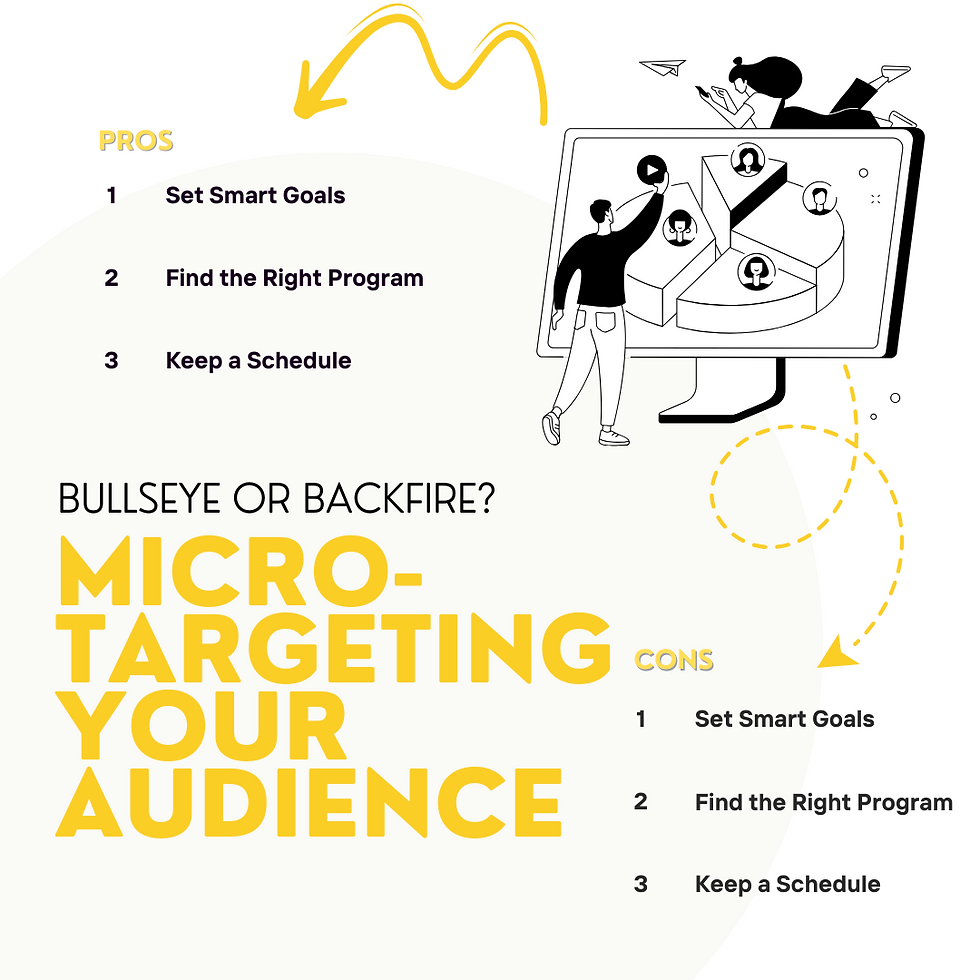Bullseye or Backfire? The Pros and Cons of Micro-Targeting Your Audience
- Riddhi Gandhi
- Nov 25, 2023
- 2 min read
Micro-targeting refers to the practice of honing in on a very specific audience segment and tailoring marketing efforts towards them. It involves gathering and analyzing data about individuals' interests, behaviors, and demographics to create highly targeted marketing messages. Here are some key points and examples to illustrate the benefits and drawbacks of micro-targeting:

Benefits of Micro-Targeting:
Better ROI: Micro-targeting can help brands maximize their return on investment by ensuring their marketing efforts are focused on the most relevant audience. By narrowing the target audience, brands can avoid wasting resources on those who are unlikely to convert.
Higher Conversion Rates: By creating targeted marketing messages that resonate with specific segments of the audience, brands can achieve higher conversion rates. When the audience feels like the brand truly understands their needs and interests, they are more likely to take action.
Better Personalization: Micro-targeting allows brands to create highly personalized marketing messages that are tailored to specific segments of the audience. This level of personalization can create a deeper connection with the audience and build stronger brand loyalty.
Examples of Brands using Micro-Targeting:
Spotify: Spotify uses micro-targeting to personalize their music recommendations for individual users based on their listening history. By analyzing user data, Spotify is able to create custom playlists and suggest new music that aligns with the user's interests.
Amazon: Amazon uses micro-targeting to recommend products to users based on their purchase history and browsing behavior. By analyzing this data, Amazon can suggest products that are highly relevant to the user's interests and increase the likelihood of a purchase.
Drawbacks of Micro-Targeting:
Privacy Concerns: The gathering and analyzing of personal data can raise privacy concerns among consumers. Brands need to be transparent about the data they are collecting and how it will be used to avoid losing the trust of their audience.
Risk of Alienating Non-Targeted Audiences: By focusing too narrowly on a specific segment of the audience, brands risk alienating non-targeted audiences. This can lead to negative brand perception and harm overall brand equity.
Limited Reach: Micro-targeting can limit the reach of marketing efforts, as it involves focusing on a small segment of the audience. Brands need to ensure they are not missing out on potential customers by solely focusing on micro-targeting.
Examples of Brands using Micro-Targeting:
Cambridge Analytica: Cambridge Analytica used micro-targeting to influence voters in the 2016 US Presidential Election by analyzing personal data collected from Facebook. The scandal resulted in a loss of trust in social media platforms and increased scrutiny of data privacy.
Pepsi: In 2017, Pepsi faced backlash over a micro-targeted ad campaign featuring Kendall Jenner. The ad was accused of trivializing social justice movements and exploiting political unrest for commercial gain, resulting in a negative impact on the brand's reputation.
In conclusion, micro-targeting can be a powerful tool for brands to create personalized marketing messages and achieve higher ROI. However, it is important to consider the potential drawbacks, including privacy concerns, alienating non-targeted audiences, and limited reach. Brands should approach micro-targeting with transparency and responsibility to maintain the trust of their audience and protect their brand reputation.




Comments